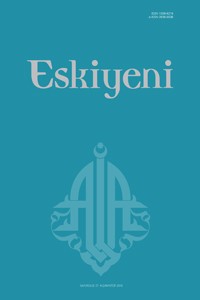Abstract
Kudüs, Semitik dinlerin (Yahudilik, Hıristiyanlık ve İslam) hepsi için, dini öneme sahip neredeyse tek şehirdir. Çok sayıda ismi olmasına rağmen, en yaygın olanı, Batı Sami tanrılarından Şalem/Salem’e atfen “Yeru-Şalem: Şalem/Salim’in şehri” olarak bilinendir. Kadim bir yerleşim yeri olan Kudüs'ün tarihi, M.Ö. 3000’e kadar geri gider. Yahudilerin de bir parçasını oluşturdukları Samilerle şehrin ilişkisi çok eskidir. Ancak Yahudilerle olan ilişkisi İbrahim’e kadar geri götürülür. Davud ve Süleyman zamanında Birleşik Yahudi krallığının başkenti olmuştur. Ancak bugünkü kutsallığına sahip gözükmez. Ancak Babillilerin Kudüs’ü işgal etmesi, mabedi yıkması ve önemli bir Yahudi kesimini Babil’e sürgüne göndermesi sonrasında kutsallık statüsünü kazanmış görünür. Bu kutsallık, ikinci mabedin yıkılmasından sonra daha da artmıştır. Her tür Yahudi düşüncesinde, Mesih’in gelişiyle kendisine dönülmesi hedeflenen/arzulanan bir şehir olmayı bugüne kadar sürdürmüştür.
References
- Armstrong, Karen. Jaruselam, One City Three Faiths. New York: Ballantine Books, 2005.
- Aydın, Fuat. Yahudilik, Tarih, İnanç, İbadet, Kültür. İstanbul: Mahya Yayınları, 2018.
- Çift, Pelin-Ömer Faruk Harman. Kudüs`ün Gizemli Tarihi. İstanbul: Destek Yayınları, 2017.
- Encyclopedia Hebraica, “Jerusalem in the Bible”, Encyclopedia of Judaica, Second Edition, 21: 208-211.
- Encyclopedia Hebraica. “Jerusalem in Aggadah”, Encyclopedia of Judaica, Second Edition, 21: 211-213.
- Harman, Ömer Faruk. “Kudüs”, Türkiye Diyanet Vakfı İslam Ansiklopedisi, İstanbul: TDV. Yayınları, 36: 323-327.
- Hasanoğlu, Eldar. “Tanah`a Göre Kudüs`ün Kutsallaşması Süreci”, Uludağ Üniversitesi İlahiyat Fakültesi Dergisi 24 (2015/2):125-148.
- Meral, Yasin. Sâmirî`nin Buzağısı, Ankara: Ankara Okulu Yayınları, 2018.
- Mert, Rabia. Mitolojik ve Tarihsel Bağlamda Kutsal Bir Mekân Olarak Kudüs. Doktora Tezi, Samsun Ondokuz Mayıs Üniversitesi, 2017.
- Montefiore, Simon Sebag. Kudüs, Bir Şehrin Biyografisi. İngilizceden çeviren Cem Demirkan, İstanbul: Pegasus Yayınları, 2016.
- Schlesinger, Meir. “Jerusalem-Chosen by God”. Tradition: A Journal of Orthodox Jewish Thought, 25/1 (Fall 1989):1-10.
Abstract
Jerusalem is the almost only city that has religious significance in the all Semitic religions (Judaism, Christianity, and Islam). It has many names. But among these names, Jerusalem is the most important. It means the city of Salem/Shalem, and Salem/Shalem is a god of West Sami gods.Jerusalem is an ancient settlement that its history goes back to BC. 3000. Its relationship with Jews seems to go back till Abraham. In the reign of David and Solomon, Jerusalem was the capital city of the United Kingdom of Jews. But It didn’t seem sacred as much as today. It won its sacredness in the time of the second exile that brings about by the occupation of the Babylonians. This sacredness, after the destruction of the second temple, increased more and more. Reconstruction of the city was associated with the coming of the Messiah. In time, Jerusalem became a city that all Jews want to return one day.
Keywords
References
- Armstrong, Karen. Jaruselam, One City Three Faiths. New York: Ballantine Books, 2005.
- Aydın, Fuat. Yahudilik, Tarih, İnanç, İbadet, Kültür. İstanbul: Mahya Yayınları, 2018.
- Çift, Pelin-Ömer Faruk Harman. Kudüs`ün Gizemli Tarihi. İstanbul: Destek Yayınları, 2017.
- Encyclopedia Hebraica, “Jerusalem in the Bible”, Encyclopedia of Judaica, Second Edition, 21: 208-211.
- Encyclopedia Hebraica. “Jerusalem in Aggadah”, Encyclopedia of Judaica, Second Edition, 21: 211-213.
- Harman, Ömer Faruk. “Kudüs”, Türkiye Diyanet Vakfı İslam Ansiklopedisi, İstanbul: TDV. Yayınları, 36: 323-327.
- Hasanoğlu, Eldar. “Tanah`a Göre Kudüs`ün Kutsallaşması Süreci”, Uludağ Üniversitesi İlahiyat Fakültesi Dergisi 24 (2015/2):125-148.
- Meral, Yasin. Sâmirî`nin Buzağısı, Ankara: Ankara Okulu Yayınları, 2018.
- Mert, Rabia. Mitolojik ve Tarihsel Bağlamda Kutsal Bir Mekân Olarak Kudüs. Doktora Tezi, Samsun Ondokuz Mayıs Üniversitesi, 2017.
- Montefiore, Simon Sebag. Kudüs, Bir Şehrin Biyografisi. İngilizceden çeviren Cem Demirkan, İstanbul: Pegasus Yayınları, 2016.
- Schlesinger, Meir. “Jerusalem-Chosen by God”. Tradition: A Journal of Orthodox Jewish Thought, 25/1 (Fall 1989):1-10.
Details
| Primary Language | Turkish |
|---|---|
| Subjects | Religious Studies |
| Journal Section | Research |
| Authors | |
| Publication Date | December 1, 2018 |
| Submission Date | November 5, 2018 |
| Published in Issue | Year 2018 Issue: 37 |


